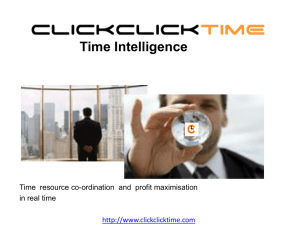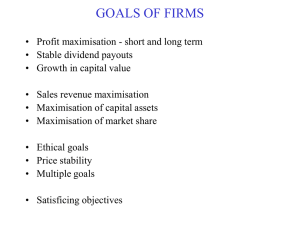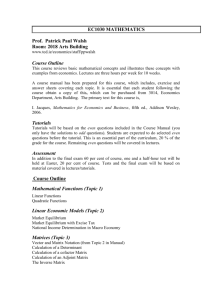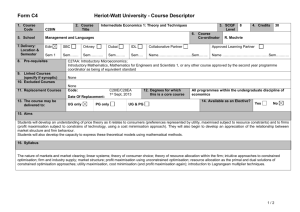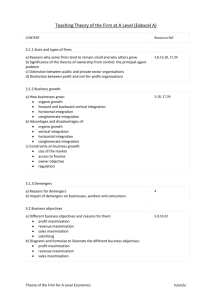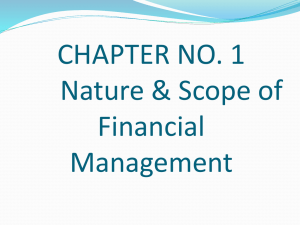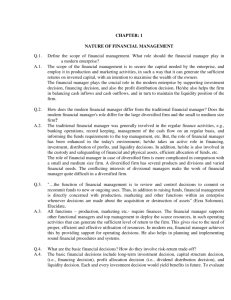Study of Financial Statements - Module B
advertisement
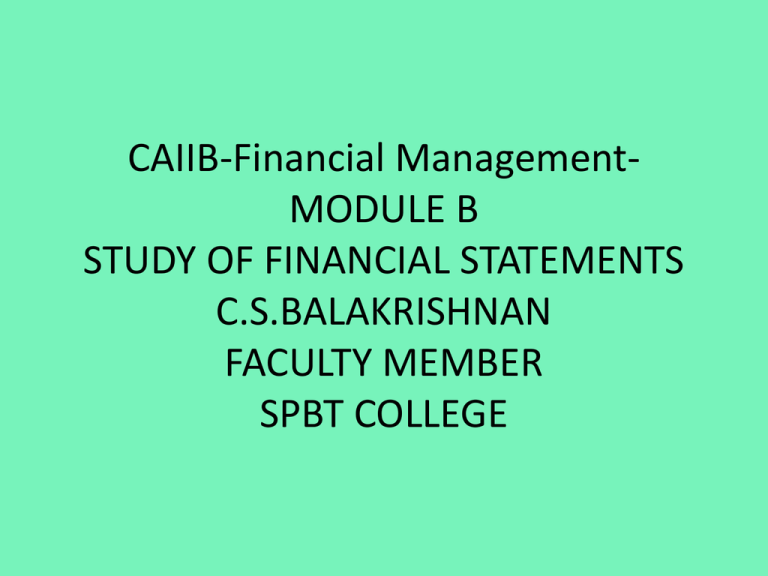
CAIIB-Financial ManagementMODULE B STUDY OF FINANCIAL STATEMENTS C.S.BALAKRISHNAN FACULTY MEMBER SPBT COLLEGE Scope,Functions and objective Scope is Designing and implementing certain plans. Ensuring effective funds utilisation by directing funds flow according to some plan. Serving as a necessary tool and technique for resources allocation to various projects of the business and providing the best guide for existing and prospective resource allocation. According to Howard and Upton “Financial management involves the application of general management principles to particular financial operation”. Attending to investment decisions as to when and how to acquire and allocate funds for short-term and long-term assets keeping in view the profit generation of the business through which repayment obligation can be met. Objectives and basic consideration of Financialmanagement. Although profit maximisation is the objective of financial management,the long-term goalof the business entity is to achieve maximising the shareholder value of the firm,since the “principle of maximisation of shareholder wealth provides a rational guide for running a business and for efficient allocation of resources in society”. The key objective of Financial Management is to maximise the value of the company.This is the result of good investment decisions,prudent financing decisions and well thought-out financial planning and control. Maximisation of the value of the company is also known as maximisation of the wealth of the owners.To achieve this,finance manager has to take careful decisions in respect of -Financing -Dividend -Investment -Current asset management. • Financing decision-Has to decide on sources of funds for business.It is to be decided whether entire capital should be raised from equity capital or a part is to be raised from loan.Hence Debt/Equity ratio or Leverage are important since each source has in them associated risk factors involved. • Investment decision-It relates to acquisition of assets.Assets are classified into real assets such as land,building,plant,equipment etc.and the financial assets are shares and debentures etc.It indicates available mix of financing to fund company’s activities.Such decisions on investment in projects come within the field of capital budgeting which is derived from net present value of assets. Dividend decision-It is basically a financing decision.This is because profit is a source of fund.By not paying dividend,the “retained earnings”or ‘reserve’can be increased which could be otherwise available for investment. This ultimately lead to maximisation of wealth of the organisation provided decisions on investments are correct. Current Asset Management-This is necessary to maintain balance between current assets and current liability,if the liquidity of the business is interrupted because of holding too much fund in current assets. Wealth maximisation &value maximisation • The goal of financial management is to maximise the value of companies.This is generally expressed in terms of maximising the value of the ownership shares of the company,in short,maximising share price.Thus,better performing companies can raise additional funds under more favourable terms.When funds go the such companies the economy’s resources are directed to more efficient use.This basic objective of maximisingthe price of the company’s shares is called ‘value maximisation’. • Social responsibility is also an important goal of a company which requires -Maximising share-price by efficient,wellmanaged operations related to consumer demand parameters. -Efficiency & innovation leads to value maximisation which leads to new products,new technologies and better employment. -External factors like pollution,product safety and job safety have acieved added dimensions in relation to value maximisation. Profit maximisation vs.Wealth maximisation • Long run vs.Short run Profits. • Convert total corporate profits to earning per share(EPS). • EPS is total profits divided by number of shares outstanding. • Assume the firm earns Rs.10 mn.and has 1mn.shares outstanding.The EPS will work out to Rs.10. • Profit maximisation is a short-term concept,while wealth maximisation emphasises the long-term view point. State whether true or false • The income statement depicts the financial position of the firm at a given point of time • The balance sheet gives the financial performance of the firm over a given period of time. • These statements are prepared every week. • Funds Flow statement gives the liquidity position of the firm. Cash Flow statement tells from where the money comes and where it is used. The prime objective of financial management is wealth maximisation,and not profit maximisation. What is earnings per share? a)Net Profit b)Profit before interest and tax c)Total earnings divided by investment d)Net profit divided by equity What is the difference between long term funds and short term funds? -Difference in interest rates -Difference in time of repayment -Difference in the size of loan -No difference CAPITAL EXPENDITURE DECISIONS AND PROFITABILITY STUDY It represents the important decisions taken by the firm. Importance due to the following issues -Long-term effects -Irreversibility -Substantial outlays • Difficulties -Measurement problems -Uncertainty -Temporal spread o Phases of capital budgeting -Capital budgeting is a complex process which may be divided into five broad phases. Planning Implementation Analysis Review. Selection • Levels of Decision Making -Operating decisions -Administrative decisions -Strategic decisions o Profitability Study important facets are -Market analysis -Technical analysis -Financial analysis -Economic analysis -Ecological analysis The basic characteristic of a capital project is that it typically involves a current outlay(or current and future outlays)of funds in expectation of a stream of benefits extending far into future. Accounting rate of return method-A selection criterion using average net income and investment outlay to compute a rate of return for a project.This method ignores the time value of money & cash flows. Internal rate of return method-A selection method using the compounding rate of return on the cash flow of the project. Net Present Value method-A selection method using the difference between the present value of the cash inflows of the project and the investment outlay.The method evaluates the differential cash flow between proposals. Payback method-A selection method in which a firm sets a maximum payback period during which cash inflow must be sufficient to recover the initial outlay.This method ignores the time value of money and cash flow beyond the pay back period. What are the three important factors which arise from capital expenditure decisions? a)Long-term effects e)Debt b)Profitability f)Substantial outlays c)Irreversibility g)Short-term effects. d)Risk Why are capital expenditure decisions difficult? i)Uncertainity in predicting costs&benefits ii)Difficulty in measurement of costs&benefits iii)Risk involved iv)Problems in estimating discount rates v)All the above • If the IRR of the project is 7% and the cost of capital is (11.4% should we reject or accept the project). Yes/No. • The firm should always make an ecological analysis to know the likely damage that may be caused by the project to the environment. a)Must do b)No need. Sources of finance and cost of capital For what purposes a firm needs a finance? Since the cash receipts lag behind cash payments necessitating loans,bonds,overdrafts etc.the firm needs finance for short term and long term requirements-fixed assets and working capital. Permanent sources of finance Share capital and retained profits. Depreciation is not a real expenditure.It is a non-cash expenditure(T/F) Depreciation amount increases the liquidity of the firm(T/F) Cost of goods sold and Cost of production refer to the same amount(T/F) Net profit is calculated before tax(T/F) Balance sheet and Income statement can be prepared every quarter for internal use(T/F) A loss is shown as asset in the balance sheet(T/F). • Provisions for taxes and accrued expenses to be paid within a year are current assets(T/F) • Debtors(also known as accounts receivable)represent the amount of money to be paid by the firm to the suppliers(T/F) • Fund Flow statements can be prepared without the basis of balance sheets(T/F). • Fund flow statements represent only bank borrowing and trade credit(T/F) • State whether following are sources or uses -Buying materials -Payment of dividend to shareholders -Advance received from buyer of goods -Investment in machinery -Issue of debentures -Retained earnings -Increase in Inventories -Sale of old machinery -Depreciation amount Study of financial statements • Who are the party interested in firm’s financial condition? Shareholders,creditors/suppliers,managers,tax authorities. • Different types of concerns of stakeholders Profitability and earning capacity,liquidity and repaying loan instalments and interest. Long term sources Preferenceshares,bonds,debentures and long term loans from financial institutions. Various sources of short term financeCash credit,overdraft,billsdiscounting,commercial papers and trade credit. Short term & long term cash forecastsTime periods involved-Yearly for long term forecasts,monthly for short term forecasts. Factors considered in equity financing Issue costs,servicing costs such as paying out dividends, and when there is retained earnings there will be capital appreciation of sharevalues. Preference Shares-These shareholders get a fixed return and their risk is less than the equity Shareholders.They have a right to the first slice of dividend.Obligation to redeem the preference shares after its time period.They do not have a right to vote. Debentures or loan financing-the firm will have to pay fixed interest very year.There is an obligation to redeem it at the end of the period.There is also an advantage of tax deductibility of interest paid which makes it cheaper. Bills rediscounting –The buyer can repay in a long period of time,while seller gets his money back by discounting the bills.For the seller,this helps him to go ahead with production and increase the turnover. Working capital term loan-A part of working capital has to be with the manufacturer,since there is a time lag between ordering and procuring.This particular portion (say25%)can be financed by long term funds.When firm is not able to infuse its own funds for this purpose,it gets a long term loan from the bank.This carries fixed interest and for a fixed period. Overdraft and bank loan-Overdraft is a running account whereas bank loan instalment are fixed. Trade credit-When materials are bought from suppliers,the trade credit is extended for few days or a couple of months.The supplier is willing to wait to collect money.This also depends on the suppliers’financial position and the buyers credit worthiness. Commercial paper-These are short term promissory notes with fixed maturity period.They are issued by very large companies who are reputed and have high credit worthiness.Credit rating agencies certify their credit rating. Firms’cost of capital-A firm’s is the average cost of capital is the weighted average arithmetic mean of the cost of resources from various sources. Questions: a)Long term sources are banks and financial institutions (T/F) b)Current liabilities should be repaid within a financial year(T/F) c)Fixed assets are generally financed with current liabilities(T/F) Equity Shareholders bear the greatest risk(T/F) Bills discounting scheme has been introduced to ease flow of funds in the economy(T/F) Trade creditors are suppliers of goods and services to whom the firm is yet to pay.(T/F) Accounts Receivables should be less than trade creditors(T/F). Bills of Exchange is same as cash credit(T/F). Equity and Preference shares are one and the same(T/F) A part of working capital can be financed by long term sources(T/F) • A firm borrows Rs.20,000 from bank @8% and floats a debenture for Rs.60,000 @6%,for a special project,what is the cost of capital of the project? a)5.5% b)6.5% c)7.5% d)8.5% • If a firm borrows Rs.2 lac @10% and has a tax rate of 40%.What is the cost of capital? a)5% b)6% c)7% d)8% • A company has issued preference share of Rs.100 face value carrying 14% dividend repayable at par after 12 years.Cost of capital after tax of 40%?a)21.22% b)23.33%c)24.23% Data for analyzing the situations of the firm Balance Sheet,Income Statement,fund flow statement. Basic concepts while preparing balance sheet -Entity concept -Money measurement concept -Going concern concept -Cost concept -Consevatism concept -Dual aspect concept Accounting period concept Accrual concept Realisation concept Matching concept Materiality concept. What is revenue reserve & capital reserve? Revenue reserves are accumulated earnings from profits and normal business operations.Capital reserves arise due to capital gains from revaluation of assets or due to premium on issue of shares. • Accounts payable-These are current liabilities payable within one year from date of balance sheet. • Fund Flow Statement-It shows the sources and uses of funds during a given accounting period. • Horizontal analysis and Vertical analysisHorizontal analysis is comparing the operations over a time period ie.comparing past performance with current position for predicting the future performance. In vertical analysis we use percentages to show the relationship between various items in the balance sheet. a)X contributes Rs.10,000 to his properietory concern and the amount is deposited in the bank.What is the nature of liability? i)Owner’s equity ii)Loan iii)Short term finance iv)Fixed Asset. b)ABC co.paid Rs.30,000 as deposit to the suppliers for a period of 3 months. i)Liability ii)Current Asset iii)Trade Credit iv)Debenture c)Materials costing Rs.2000 destroyed by fire i)Asset ii)Liability • Moving over to other questions.
